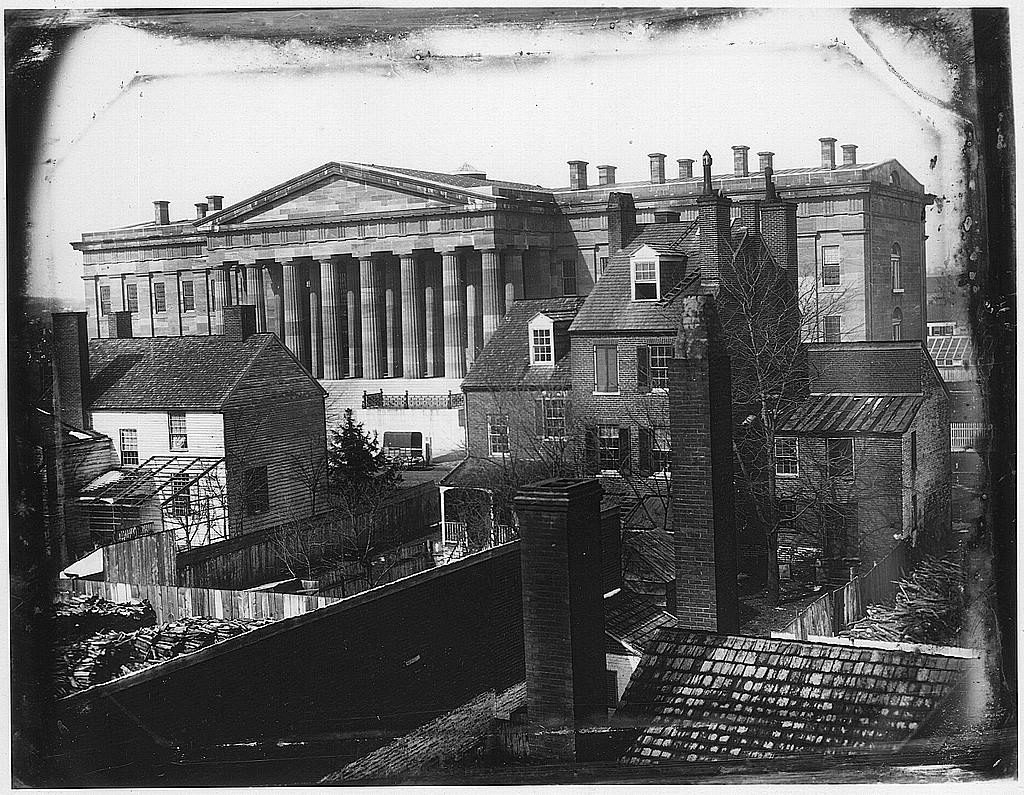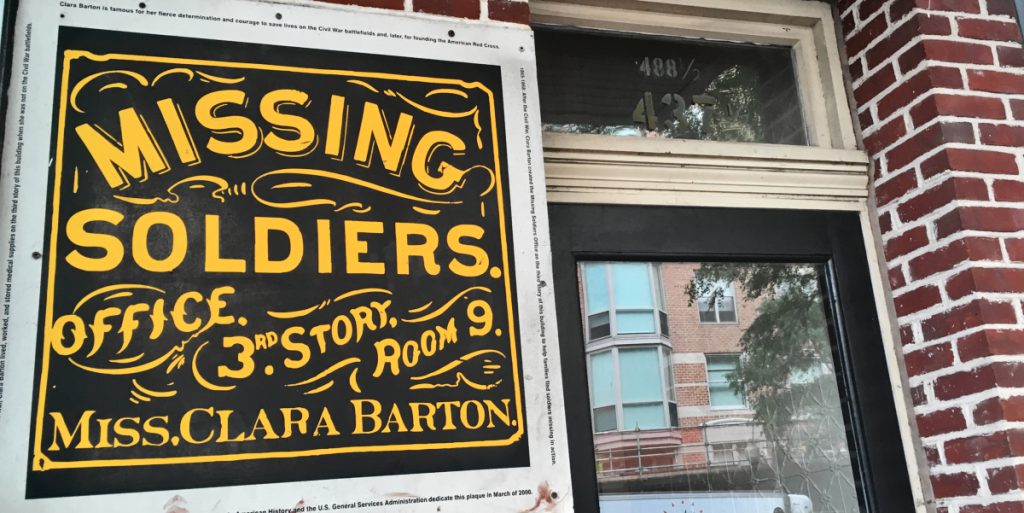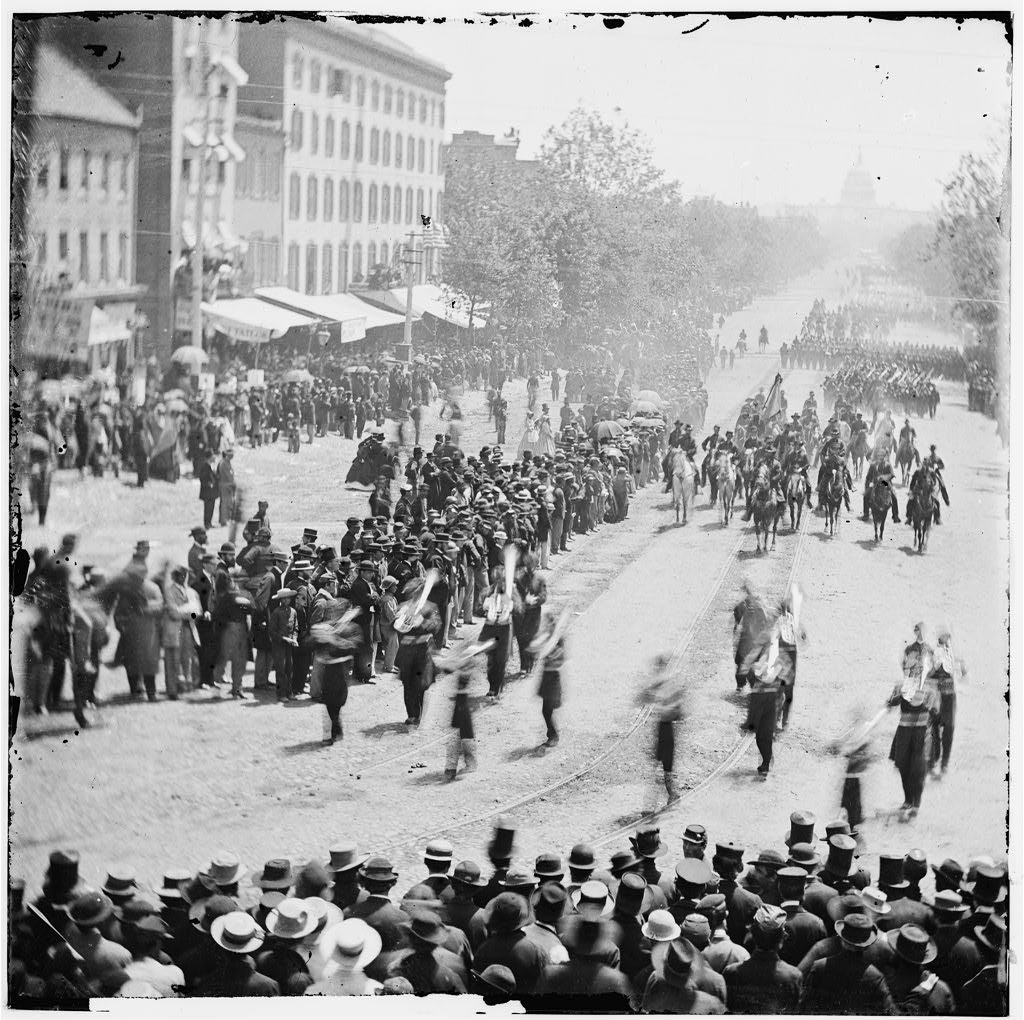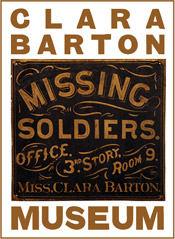Nosy Neighbors: Clara Barton and Horatio Nelson Taft
In late 1864, a new tenant moved into the boardinghouse at 488 ½ 7th Street in Washington, DC where Clara Barton lived.
His name was Horatio Nelson Taft and he moved into the rooms managed by landlord Edward Shaw to be close to the United States Patent Office where Taft worked as a patent examiner. Taft rented a room overlooking 7th Street, just down the hall from the room utilized by Clara Barton as a bedroom and supply depot for her Civil War work.

The US Patent Office c 1846 where Clara Barton, and later Horatio Nelson Taft, worked.
Taft kept an incredible diary during the Civil War, documenting major events and life in the nation’s capital during this crucial period. On December 1, 1864, he jotted down in his journal that he had moved to 7th Street between D and E streets.
I have changed my “base” since my last date. I am now in 488½ on 7th Between D & E Streets, have a large front room on third floor. There are six rooms on this floor, all occupied by very quiet lodgers. Mr Edward Shaw rents the whole floor and sublets the rooms keeping one himself, which he has occupied for eleven years past.
Three days later, he added a post-script about his room at 488 ½ 7th Street.
I returned to my room, “Shaw Settlement” as we call it, before 9 o’clk. My room is 16 by 21 feet and ceiling 10 feet high with two large front windows.
His early journal entries from “Shaw’s Settlement” don’t mention the humanitarian who lived down the hall. Clara Barton wasn’t home when Horatio Taft moved into the boardinghouse. Instead, she was splitting time between a hospital at Petersburg, Virginia and Camp Parole in Annapolis, Maryland, where her efforts to find missing Union soldiers began.

The Missing Soldiers Office operated out of the building where Barton and Taft both lived
Taft’s diary does eventually turn to Clara Barton. In May 1865, Taft ventured out to watch the Grand Review of the Armies that took place in Washington after the conclusion of the Civil War. In his lengthy, fascinating entry on the Review, he finally comes to Clara Barton and gives his opinion of her work on the battlefields of the conflict.
Washington
Wednesday May 24th 1865
Yesterday and today have been “great days” in Washington. The great Military Review closed this afternoon. The Civil Offices of the Govt have all been closed during the two days, and but little else has been done in the City but looking at Soldiers marching through the Avenue. The Army of the Potomac, Genl Meade. The Army of Tennessee and of Georgia, Genl Sherman, were reviewed. Yesterday the Army of the Potomac, and today Sherman, the whole numbering about One hundred and Sixty thousand. It took Six hours Each day for them to March by…
… the Grand Review will long be remembered as the most magnificent spectacle of the kind ever witnessed on the continent. Standing at the Treasury one could see near a mile and a quarter (to the Capitol Gate). This space through the Ave was filled for Six hours each day with a moving mass of men with polished gun and gleaming bayonet and all the other branches of the Service…

The Grand Review
The Sidewalks, the Doors, and windows and the House tops were crowded with spectators who were cheering constantly as some favorite officer or Regt was passing but more than all when some of the “Colors” blackened and tattered and hanging in shreds from the Staff was held aloft by the proud color bearers…
Some females rode in the Review yesterday and today who I was told had been “through the War.” Some officers and soldiers wives and some “Daughters of the Regiment,” who had followed their Brothers or Fathers or husbands, and shared their dangers, taking care of the wounded, and nursing the sick. One of this Class I am acquainted with, but she left the Army of the Potomac some three months ago, Miss Clara Barton of Worcester Mass. She has been known and called the “Angel of the Battlefield.”
She was in Fredericksburgh during the terrible “Burnside Battle” there having crossed the River on the Pontoon Bridge while the Rebels were shelling it. She was there again last summer when the City was filled with our wounded from the Battle fields of the “Wilderness.” She afterwards went with the Army to Petersburgh and administered to the wounded in the field Hospitals being frequently under fire in carrying relief to the Wounded on the field. I am told that she seemed on such occasions totaly insensible to danger. She is highly educated and refined, and few ladies ar[e] as inteligent as She is.
You can read Taft’s diary thanks to the efforts of the Library of Congress. The Taft diary is digitized and includes a transcription. You can find Taft’s entry about Clara Barton by clicking HERE.
A special thank you to Michelle Krowl at the Library of Congress for sharing this incredible piece of history with us.
Want to learn more? Follow us on Facebook and Twitter to discover more stories from Civil War medicine!
Become a museum member and support our educational programs and research like this.
About the Author
Jake Wynn is the Director of Interpretation at the National Museum of Civil War Medicine. He also writes independently at the Wynning History blog.
Tags: Clara Barton, Horatio Nelson Taft, Missing Soldiers Office, The Grand Review, Washington, Washington DC Posted in: Uncategorized
